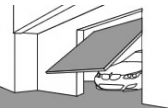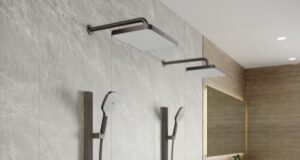
Hinged tilt doors are commonly used for garages and sheds, and offer a simple and cost-effective way to create a large, accessible opening.

What is a tilt door?
Tilt doors are a type of garage door. They consist of a single large panel connected to two hinges and various springs at the top of the door on the left and right sides. The door is lifted to open it, and it tilts back and into the top of the building by swinging out and up.
Tilt doors will suit practically any landscape, as the single panel can be painted any colour or clad in any number of different materials to provide interesting and unique effects. Tilt doors do require a certain amount of clearance though, both in the swing arc and the ceiling of the building to allow room for the door.
How tilt doors work?
As the door is lifted, powerful extension springs on the top of the door contract, pulling the door up and into the building. There are two types of spring hinge for tilt doors, the lighter ‘jamb hinge’ and the heavier ‘track hinge’. The jamb hinge allows the door to protrude out from the building by up to half of its height, while the track hinge hides most of the door back within the building. Because these doors sit below the ceiling, you will need to ensure they leave plenty of clearance around light fittings.
Where are tilt doors used?
These are invariably seen in households as garage doors, carport doors and in larger sheds. They are rarely used in houses, but can make for an interesting rear facing wall/door if framed with glass panels.
What variations exist in tilt doors?
One variation on the conventional tilt door is the flex door. Flex doors use a roller door style corrugated curtain, but instead of rolling up the door, it follows a track along the ceiling to sit just below it, like a tilt door does. A similar style to this is the sectional door which has several panels hinged together. Each panel rotates as it gets to the top of the door and travels along a track to sit below the ceiling.
|
Advantages
|
Disadvantages
|





